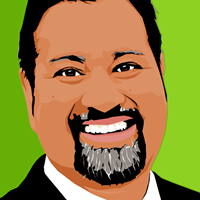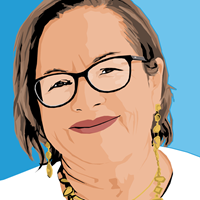5 investors provide insight into a new market for producers
Although she’s spent years working in the financial industry and helping her insurance executive husband build a substantial nest egg, Ana Sexton has never sought advice from a financial planner herself. Neither has Viridiana Ramirez, who owns a business and several real estate investments. Nor has Catalina Stricklett, despite her quest to retire “at a decent age.” And they’re not alone. Although Hispanics make up one of the fastest growing segments of the U.S. population—in terms of both numbers and income—it turns out that they’re less likely than other groups in the U.S. to seek out the services of financial professionals, making them a relatively untapped opportunity for producers.
Consider this: According to the 2020 U.S. Census Bureau, 19% of all Americans are Hispanic. The 2022 Hispanic Market Report by Claritas predicts this figure will rise to 22% by 2028. The size of the community, combined with what Claritas estimates is more than $2 trillion in consumer buying power, indicates that Hispanics represent a significant portion of the nation’s economy. In fact, notes a 2022 Ipsos report titled “Hispanics are Gaining Wealth in America,” “of all the affluent subgroups in the United States, Hispanics now represent the largest, with particular growth among the younger generations.” According to Ipsos, one in five Hispanics are considered affluent.
Still, while Bloomberg Linea reports that, “Latinos and Hispanics in the U.S. are among those who have shown the most progress in the number of millionaires in the country,” they are also “among those who invest the least in equity.” Moreover, the 2021 TIAA Institute-GFLEC Personal Finance Index found that Hispanics have lower levels of financial literacy than do white Americans, and, says Morningstar, “more than two-thirds of Hispanic households aren’t saving anything through employer-sponsored plans like 401(k)s, and only 8% report having an individual retirement account or similar plan.” In addition, a 2021 Bankrate.com survey showed that “49% of Hispanics don’t currently own individual stocks, mutual funds, bonds, exchange-traded funds, cryptocurrency, or real estate.”
So, why aren’t more Hispanics working with financial professionals to build their prosperity? Given the many cultural differences within the Hispanic market, the answers can vary depending on the age, country of birth, occupation, education level, and gender. But there are some common reasons, as we discovered when we spoke with a number of Hispanic sources, both immigrants and native born, to see what role—if any—financial planning plays in their lives, and how financial professionals might help them in the future.
Libier Bermudez: Realizing the American dream
“In Costa Rica, there was no such thing as credit,” says Libier Bermudez, who moved to the U.S. from Costa Rica in 1997. “If you wanted something, you saved for it.” As a result, Bermudez, who has long worked in the financial industry, built up his savings account before exploring other ways to use his money. Acting cautiously, his first move was to buy life insurance, and in his 30s, he began to contribute to a 401(k) after he attended an information meeting that a financial planner conducted, aimed at his age group. His perception shifted from “that’s only for rich people” and “they are going to charge me a lot of money to tell me things I already know” to realizing that a savings account alone would not help him achieve his ultimate goal of a comfortable retirement.
In addition to helping Bermudez overcome his concerns about hidden fees and risk factors, the producer mapped out long-term strategy designed for him and made him realize the power of compound interest. Now as a married, 48-year-old father of two adult children, Bermudez works with two financial professionals, one for short-term investments and one for longer-term investments. Given this experience, he emphasizes that a financial professional’s added value is often different for those born here and raised middle class versus people born elsewhere and raised lower class. He believes he is speaking on behalf of other first-generation Americans when he notes that “We can realize the American dream here, but we often need financial planning more than the people who were already born here and have been exposed to the American dream for longer. We need more visibility for the opportunities on both ends—for both the Hispanic community and the financial professionals.”
Viridiana Ramirez: Open to opportunities
Business owner Viridiana Ramirez agrees, though, at present, her agreement is strictly theoretical. Despite co-owning a successful construction company and several real estate assets with her husband, neither of the Ramirezes has ever worked with a financial professional. The reason: no financial professional has ever approached them. “Most of us in the Latin community have no idea what exactly a financial professional does or what it costs,” she says.
Ramirez is from Mexico and her husband is from Colombia, and they are currently focused primarily on retirement, education for their two young sons, and ensuring that they have money in case of an emergency. To achieve this, they own a building and some land, but, Ramirez says, they are open to opportunities. “If it’s going to help me, I’m going to invest in it,” she says, but, should she end up seeking the services of a financial planner, it’s important that they be extremely patient with her. “I ask a lot of questions,” she says. “I go back and do my research, and I come back with even more questions. I need someone who will answer my questions and give me all the feedback that I need.” Would it be important for this producer to be bilingual? Not for her, she says, though she concedes it could be helpful for many people in order for them “to absorb all the details.”
Ana Sexton: ‘I understand what I need’
“Customers really do prefer to speak in Spanish,” says 67-year-old Ana Sexton, whose position at a financial services group puts her in direct contact with Hispanic clients, for whom she services 401(k) plans. A Honduras native who grew up in California, Sexton emphasizes that speaking the language helps to exhibit cultural understanding. “The most important thing is trust and education,” she explains, noting that 401(k)s are not well known throughout the Latino community. “Hispanics definitely take more time because they often don’t understand market fluctuation and they may be afraid you are stealing their money,” she says.
Sexton, now a grandmother of seven, notes that in her younger days, she spent “frivolously” on new clothes and cars and had a carefree “live for today” attitude that she says is common in her culture. This began to shift when she started working in the financial world and saw client accounts grow. She also married an insurance agent. He believed in buying land, so in addition to putting money into a 401(k), they purchased acreage in Iowa. When they first started a family, they carried a lot of life insurance, but “now that we are financially stable, we feel like we are better off investing the money.”
Working in the financial industry has given Sexton confidence in her own ability to manage her family’s wealth, but it’s also fostered a skepticism about the system. “I understand what I need for my retirement,” she says, adding that she believes most financial professionals will not listen or truly understand individual needs because they’re pressured to meet institutional goals. As a result, she’s chosen not to work directly with a financial professional herself.
Catalina Stricklett: A modest lifestyle
Like Ramirez and Sexton, Colombian-born Catalina Stricklett has never worked with a financial professional. She and her husband have two dogs and no children, and between the two of them, she says her husband is the one that likes to spend money, while she has always been a saver. “I’ve seen other families struggle,” she says, “so since I can remember, I’ve always wanted to save.” At 49, Stricklett has a 401(k), a savings account, a home that is nearly paid in full, and a goal to retire at “a decent age when I can still enjoy life.”
She and her husband live modestly and do not feel the need, she says, to put their wealth on display. “In the Latino community,” she says, “many people like to show off and spend money they don’t really have,” leaving little money to save or invest. Although she knows people who have successfully used a financial professional, these people have never shared details of their experience with her. The bottom line: Stricklett says she doesn’t want to pay extra fees and is fearful of being scammed, something she has seen happen in Colombia. “If I had millions, I would need help,” she says. “But I don’t make the kind of money to need somebody to manage it,” though she adds that she might change her mind if she received an inheritance or a large lump sum. If that opportunity arose, Stricklett says it wouldn’t matter if the producer was bilingual. In fact, she notes, she is “more familiar with the terminology in English than in Spanish.”
Perla Brito: Changes through the generations
In contrast, 37-year-old Perla Brito feels that it’s very important for financial professionals who work with Hispanics to be bilingual. “My mom doesn’t speak English,” she says. “To really make that connection, you have to be able to speak the language.” As one of five children of Mexican descent, Brito, who was raised in Texas, helps care for her parents financially. Her husband, who is Dominican, does the same for his parents. Her mother never went to high school, but Brito went to community college. The mother of three girls, she now works in a civilian capacity at the Patrick Space Force Base in Florida, where her husband is in the U.S. Air Force.
Brito says her goal is “to have enough money to retire and not have to burden my kids.” Both she and her husband contribute to their Thrift Savings Plans (TSP), and they purchased their home in Florida. Though many resources are available to them through the military, they do not work with a financial professional, since, she says, all of their income is allocated to staying afloat. They have spoken to a professional in the past, and as a result, they moved some of their TSP money to higher-risk investments. “I’ve always wanted to play it safe, but I understand that if you don’t take risks, your money might not grow as much,” she says. Regardless, the couple prefers to remain conservative and to take pride in the financial progress they’ve achieved until they have time to learn more and build a trusting relationship with a financial professional. “Our parents didn’t have the same opportunities we had,” she explains. “Now we make enough to have retirement accounts, and our kids have savings accounts at a young age that we didn’t have. Little changes through generations are good.”
Turning skepticism into opportunity
As many of the Hispanics interviewed for this article indicated, there are a number of barriers keeping them from engaging with financial professionals. These include: not understanding exactly what producers do, not being familiar with financial instruments, not trusting producers’ motives, not feeling they need or can afford the assistance that producers provide, and simply preferring to rely on their own guidance.
Javier Pena, a multicultural manager at Global Atlantic, has found there are some key steps financial professionals can take to help this population overcome these barriers. For example, he says, producers should:
- Work to build authentic and trusting relationships with the Latino community by serving on the boards of directors of Latino nonprofit organizations, participating in Hispanic chambers of commerce, and sponsoring Latino events and programs.
- Leverage word of mouth as well as both formal and informal referral channels. As a collectivist culture, the Latino community tends to work together to focus on the group's needs, rather than on individual issues. This orientation, combined with an inherent distrust of institutions, lends greater weight to word-of-mouth referrals.
- Offer culturally relevant education sessions focused on the role of financial professionals, fee structures, and the like, targeted to the age and population you are looking to work with. These can be in English, Spanish, or both depending on the group. Transparency is crucial when you are seeking to build trust.
- Develop strategic relationships with those companies that employ the affluent Hispanic individuals in your community. When exploring financial solutions or even looking at retirement, these employers can be a rich source of referrals and feedback for your products and services.
Share
Related resources
More on Multicultural Markets
Your Thriving
Practice
A destination to empower financial professionals to build, manage, and grow their practice
Get started with Global Atlantic
Take the next step with a company that can help elevate your business.
Need help?
Find all the contact information to submit and service your business.















